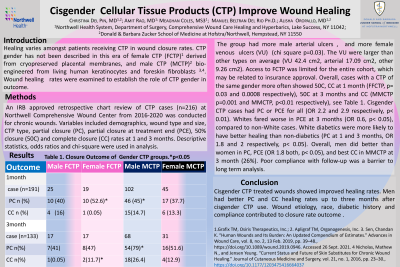Clinical Research
(CR-013) Cisgender Cellular Tissue Products (CTP) Improve Wound Healing
Friday, April 28, 2023
7:15 PM - 8:30 PM East Coast USA Time

Amit Rao, M.D. – Project Manager, Surgery, Northwell Health Comprehensive Wound Healing & Hyperbaric Center; Meaghan Coles, B.S. – Visiting Scholar, Surgery, Zucker School of Medicine at Hofstra/Northwell; Manuel Beltran Del Rio, PhD – Research Associate, Surgery; Alisha Oropallo, M.D. – Medical Director, Surgery, Northwell Health Comprehensive Wound Healing & Hyperbaric Center
Introduction: Healing varies amongst patients receiving CTP in wound closure rates. CTP gender has not been described in this era of female CTP (FCTP)1 derived from cryopreserved placental membranes, and male CTP (MCTP)2 bio-engineered from living human keratinocytes and foreskin fibroblasts. Wound healing rates were examined to establish the role of CTP gender in outcome.
Methods: An IRB approved retrospective chart review of CTP cases (n=216) at Northwell Comprehensive Wound Center from 2016-2020 was conducted for chronic wounds. Variables included demographics, wound type and size, CTP type, partial closure (PC), partial closure at treatment end (PCE), 50% closure (50C) and complete closure (CC) rates at 1 and 3 months. Descriptive statistics, odds ratios and chi-square were used in analysis.
Results: The group had more male arterial ulcers, and more female venous ulcers (VU) (chi square p=0.03). The VU were larger than other types on average (VU 42.4 cm2, arterial 17.09 cm2, other 9.26 cm2). Access to FCTP was limited for the entire cohort, which may be related to insurance approval. Overall, cases with a CTP of the same gender more often showed 50C, CC at 1 month (FFCTP, p= 0.03 and 0.0008 respectively), 50C at 3 months and CC (MMCTP p=0.001 and MMCTP, p< .01 respectively). Cisgender CTP cases had PC or PCE for all (OR 2.2 and 2.9 respectively, p< 0.01). Whites fared worse in PCE at 3 months (OR 0.6, p< 0.05), compared to non-White cases. White diabetics were more likely to have better healing than non-diabetics (PC at 1 and 3 months, OR 1.8 and 2 respectively, p< 0.05). Overall, men did better than women in PC, PCE (OR 1.8 both, p< 0.05), and best CC in MMCTP at 3 month (26%). Poor compliance with follow-up was a barrier to long term analysis.
Discussion: Cisgender CTP treated wounds showed improved healing rates. Men had better PC and CC healing rates up to three months after cisgender CTP use. Wound etiology, race, diabetic history and compliance contributed to closure rate outcome.
Methods: An IRB approved retrospective chart review of CTP cases (n=216) at Northwell Comprehensive Wound Center from 2016-2020 was conducted for chronic wounds. Variables included demographics, wound type and size, CTP type, partial closure (PC), partial closure at treatment end (PCE), 50% closure (50C) and complete closure (CC) rates at 1 and 3 months. Descriptive statistics, odds ratios and chi-square were used in analysis.
Results: The group had more male arterial ulcers, and more female venous ulcers (VU) (chi square p=0.03). The VU were larger than other types on average (VU 42.4 cm2, arterial 17.09 cm2, other 9.26 cm2). Access to FCTP was limited for the entire cohort, which may be related to insurance approval. Overall, cases with a CTP of the same gender more often showed 50C, CC at 1 month (FFCTP, p= 0.03 and 0.0008 respectively), 50C at 3 months and CC (MMCTP p=0.001 and MMCTP, p< .01 respectively). Cisgender CTP cases had PC or PCE for all (OR 2.2 and 2.9 respectively, p< 0.01). Whites fared worse in PCE at 3 months (OR 0.6, p< 0.05), compared to non-White cases. White diabetics were more likely to have better healing than non-diabetics (PC at 1 and 3 months, OR 1.8 and 2 respectively, p< 0.05). Overall, men did better than women in PC, PCE (OR 1.8 both, p< 0.05), and best CC in MMCTP at 3 month (26%). Poor compliance with follow-up was a barrier to long term analysis.
Discussion: Cisgender CTP treated wounds showed improved healing rates. Men had better PC and CC healing rates up to three months after cisgender CTP use. Wound etiology, race, diabetic history and compliance contributed to closure rate outcome.

.png)